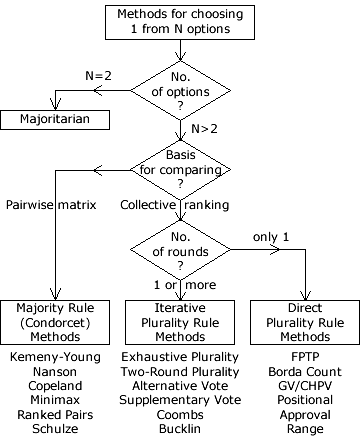Comparisons: Plurality Rule Methods 1
Single-winner voting systems employ a diverse range of approaches to the common task of choosing the best of the numerous options. As witnessed in the preceding sections, these approaches include weighting preferences, making pairwise comparisons, eliminating candidates and transferring votes. Since they are essentially different ways of solving the same problem, is there any general underlying principle that they all follow?
When there are only two options and one is supported by more voters than the other, then clearly the only fair outcome is to choose the more popular one. This rule is known as the majority rule. Using this clear-cut principle, choices involving three or more options may then be reduced to a set or matrix of pairwise comparisons from which the collective ranking is somehow deduced. Hence, Condorcet methods can be described as majority rule ones.
Non-Condorcet methods might then appear to be a disparate bunch of voting systems that employ somewhat arbitrary algorithms. However, unless they are blatantly unfair in not choosing the best option they themselves identify, they all follow another general principle instead. This alternative to the majority rule is the plurality rule.
Plurality Rule
Definition: For an anonymous and neutral voting system that chooses one or a few from many options, the plurality rule applies when, during each vote-processing round, that system establishes a tally for each option, ranks the options according to those tallies and selects a subset of options with the highest tallies.
Anonymity simply means that all voters are treated as equals by the voting system and, similarly, neutrality means that all options are treated as equals by it too. Notice that the voting system may choose single or multiple winners as the rule is independent of the number to be chosen.
Plurality Rule Methods

Voting systems that are compliant with the plurality rule (PR) may then be described as PR methods; see the diagram opposite. Within such methods, another distinction can be made; namely between those that only require one round of counting and the remainder that may need more than a single round to identify the winner.
Single-round or 'direct' PR single-winner methods do not require the winner to achieve a majority of the tallies but just a plurality of them. In contrast, multiple-round or 'iterative' PR single-winner methods require winners to have both a plurality and a majority of the tallies by the final round.
Clearly, the first-past-the-post (FPTP) system, the Borda Count and every positional voting system such as GV and CHPV are all direct PR methods. A fixed tally is derived for every option before they are collectively ranked and the one with the highest tally wins. Only when a tie exists between two or more top-ranked candidates does the subset of options contain more than one candidate. Such ties must then be resolved by random selection or another fair means.
Approval voting is where each voter may cast a vote for every option they 'approve of' thereby implicitly casting a vote against every other (disapproved of) option. Under range voting, each voter awards a score (within a defined range) to each option instead of completing a ranked ballot. Both these systems are direct PR methods as the tallies are again fixed after a single round of counting.
The iterative PR methods require the winner to achieve a majority. They accomplish this outcome by eliminating options, adjusting tallies or both at each stage of the count. In each round, exhaustive plurality retains all the options with a higher tally than the least popular one. The two-round version crudely speeds up this process by eliminating all but the two top-ranked options after the first round. The alternative vote successively eliminates the least popular option and appropriately raises the tallies of the remaining ones until one option reaches a majority. Similarly, the supplementary vote is a crude two-round version of the (exhaustive) alternative vote as only first and second preferences are permitted on each ballot.
The Coombs method is essentially an exhaustive anti-plurality one. Here, voters award one vote to every candidate bar their least favourite. At each stage of the count, the least popular option is eliminated until only one has majority support. For Bucklin voting, only the first preferences are counted in the first round. If no majority exists, second preferences are then accumulated into the candidate tallies. Where necessary, the next lower rank of preferences are included too until a majority of the votes is eventually achieved. If more than one option has a majority, then the highest one wins.
Proceed to next page > Comparisons: Plurality Rule Methods 2
Return to previous page > Comparisons: Alternative Vote (IRV)
